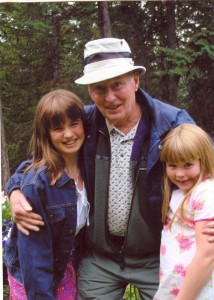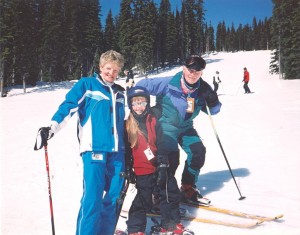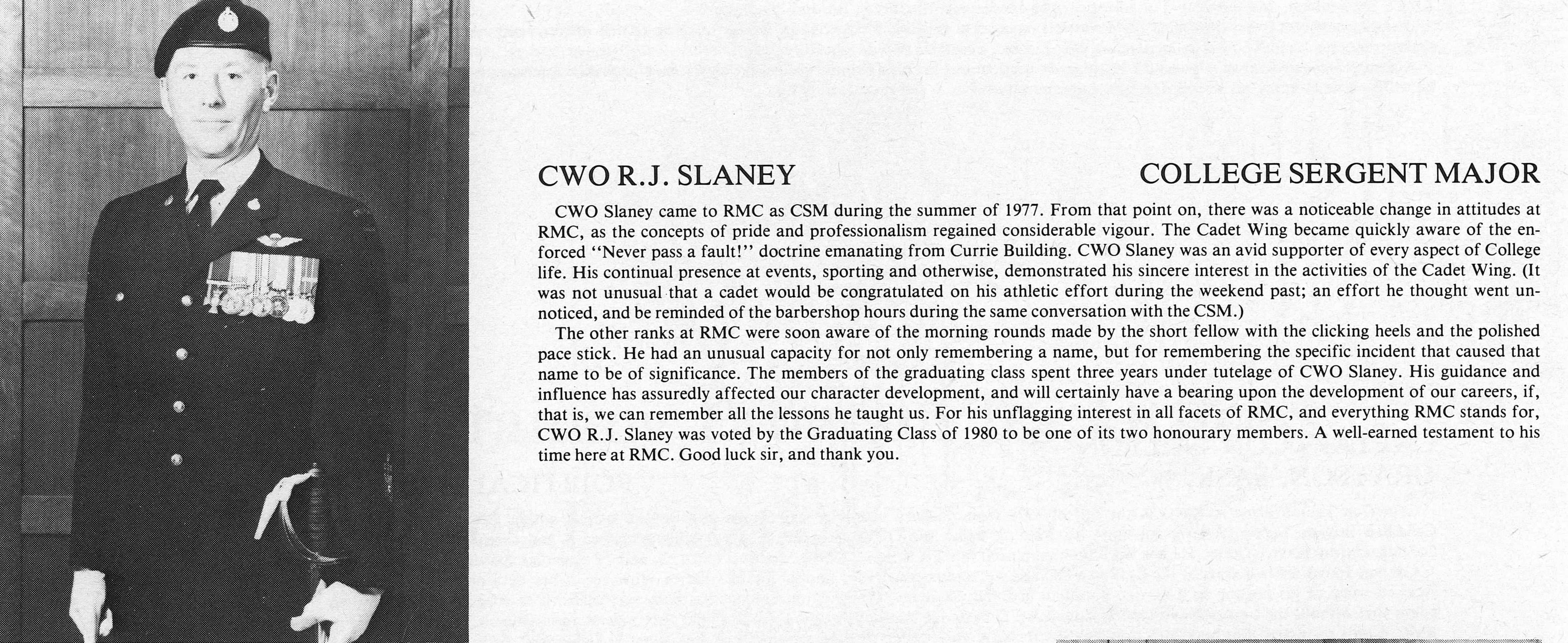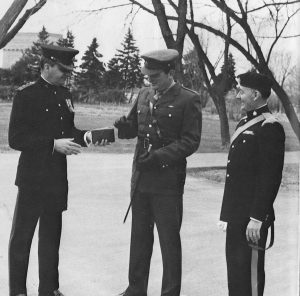
Chief Warrant Officer Robert Joseph Slaney OMM, CD
Royal Military College Sergeant Major: 1977 to 1980
E3161 Victoria Edwards (RMC 2003) interviewed Chief Warrant Officer (Ret’d) Robert Joseph Slaney OMM, CD who was the Royal Military College Sergeant Major from July 1, 1977-1980.
2008: Robert Joseph Slaney with granddaughter, Kelty (11), Jaxon (6)
Promoted to Chief Warrant Officer in 1968, he served as Regimental Sergeant Major (RSM), Fort Garry Horse in Calgary. He was posted as RSM, Lord Strathcona Horse, Royal Canadians 1970. From 1970-1973, he was RSM, Royal Canadian Armour Corps. He was then RSM, Canadian Forces Officer Candidate School from 1973-1977.
He had the privilege to serve as Royal Military College Sergeant Major from 1977-1980. He spent five years in Germany as Command Chief Warrant Officer, Canadian Forces Europe from 1980-5. Upon his return to Canada, he served as Academy Chief Warrant Officer, Canadian Forces Leadership Academy, Camp Borden from 1985-7. He retired from the Canadian Forces in 1987. Mr. Slaney lives in Westbank, BC with his wife Anne. In retirement, Mr. Slaney enjoys playing seniors hockey, walking in summer and playing with his granddaughters, who are 7 and 12 years old. A ski enthusiast, he recently watched his granddaughters compete in the Nancy Green sky races at the nearby Big White Resort, where his son is the director of ski operations. If you are a skier, please join him at the Big White Resort.
Robert Joseph Slaney at Big White Ski Resort with Ann & Kelty (Grand Daughter) 2005
They called me Mr. Slaney.
e-veritas: What were your tasks, as Cadet Sergeant Major?
Mr. Slaney: I ensured that the 3 D’s” (Dress, Drill and Deportment) of cadets was first class. Deportment is the standard of behaviour which includes conduct, professionalism, leadership, demeanor, maturity and exercise of authority. I arranged formal parades and drill training for cadets. The drill and ceremonial procedures used by the College was as described in a Manual of Drill and Ceremonial I put together. The purpose of the manual was to amplify the procedures that were deemed incomplete and to identify those procedures that the College perpetuated by custom and choice. I was also responsible for the dress and deportment of the other ranks at the College. I worked closely with a great team: Commandant H4860 General (Ret’d) John de Chastelain (RMC 1960); Director of Cadets, 4154 LCol John Annand (RRMC 1958), and Director of Administration Col Frank Lahofski.
e-veritas: I understand that you were honoured as a member of the graduating class of 1980 at RMC and as an Officer of Military Merit.
Mr. Slaney: The commemorative plaque dated 24th May 1980 on the wall of my study reads: “Let it be known to all officers and men that Chief Warrant Officer Robert Joseph Slaney OMM, CD is herby proclaimed to be an honourary graduate of Royal Military College class of 1980. This honour is bestowed in recognition of his contribution to the College as College Sergeant Major from 1970-80, his exemplary dedication to the professional development of the Cadet Wing and for his unflagging interest in the activities of the College. The Order of Military Merit has three levels or grades, with applicable post-nominal letters: The Officer of Military Merit (O.M.M.) awarded by Governor General H14513 Edward Schreyer in 1978 recognizes outstanding meritorious service in duties of responsibility. The Officer of Military Merit (OMM) decoration, which is normally for Majors and up, was initiated while I served as College Sergeant Major at RMC. The Member of Military Merit (MMM) awarded by Governor General Michenor in 1973 recognizes exceptional service or performance of duty.
e-veritas: What memories do you have of your time at RMC?
Mr. Slaney: My time at the RMC was enjoyable. I have many warm memories as the Royal Military College Sergeant Major from July 1, 1977-1980. The Officer Cadets called me Mr. Slaney, other than the odd one who called me Sir. In turn, I called the cadets Mr. The current Commandant, BGen Tom Lawson was Mr. Lawson. I knew every cadet by name in the college. Many of the cadets have served, and continue to serve, world-wide as individual United Nations observers, staff officers and commanders, in the various operational-level headquarters supporting NATO and other operations and as leaders in private industry and the public service. I enjoyed watching the cadets play intramurals, particularly basketball, football, and soccer most evenings and weekends. Athletics provided the cadets excellent opportunities to leadership skills and I learned valuable information about the cadets’ performance on and off the fields. As part of my own physical training program, I played sports and participated in the annual run around Fort Henry.
My daughter, Heather was the unofficial mascot of the RMC basketball team. One of the top cadets, Chris Konick, a great basketball player who later perished in a CF 18 accident, gave us his photograph as a memento.
In the intervening decades since I left the College, I have enjoyed running in former cadets and staff. I was reminiscing with 12411 Major (Ret’d) Paul J Ellis (CMR RMC 1980), an AERE officer, at a hockey game a month ago. As a cadet, Mr. Ellis was a fine looking young man who competed on the water polo team; today he skies and swims and his son plays hockey with the local junior hockey team.
e-veritas: What were your favourite traditions at the College?
Mr. Slaney: The College holds a traditional Christmas dinner for the cadets and staff just prior to the commencement of Christmas holidays. At the dinner, the cadets are paraded in and seated by squadrons. The youngest cadet is appointed as the Commandant for the dinner. I remained the Regimental Sergeant Major. Prior to grace, the youngest cadet and the Commandant exchange tunics. Following grace and the carving of a symbolic turkey by the Commanding Officer(s) and Regimental Sergeant(s) Major, the officers, warrant officers and senior non-commissioned officers serve the soldiers their dinner. Once this is done, they themselves may eat. Following the dinner, the Commandant ends the dinner with a Christmas message and granted a stand down to signify the start of the holiday season. At Christmas, my wife Anne made a big batch of shortbread cookies for the cadets. In recent years, my son and I and our wives serve a ‘mini company’ Xmas dinner at the Big White Resort to 140 ski instructors and staff.
e-veritas: Describe your residence at the College.
Mr. Slaney: At the time, the College RMC’s official residence was the rubble stone Gatehouse by the Memorial Arch [c. 1896]. The location at the entrance to Point Frederick on the Peninsula was ideal, and we had a lot of good times in that house. During the annual boxing tournament, my wife Anne and I invited the Cadet Wing Commander and cadets for dinner in the Gatehouse. Mr. Coggins, who had been College Sergeant Major and boxing coach during the 1930s, regaled the other guests with stories of his experiences at the College before the war.
The gatehouse, [a Recognized Federal Heritage Building commemorated in 1973 as part of a National Historic Site] was a drafty old house. During the rainy season, the basement was often wet. There were squirrels in the house all the time. My wife Anne threatened to leave the house one day when she found a rat hanging on the outside of the basement door.
e-veritas: What was the biggest challenges you had to deal with at the college?
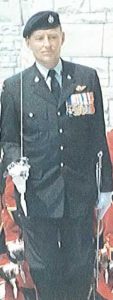 Mr. Slaney: As cadet sergeant major, my primary interest was in the military parts of the college training: military regulations and customs as well as leadership techniques and acquire the fundamental military skills of drill, dress, deportment, weapon handling and first aid. In my day, cadets were recruited almost exclusively directly out of high school; and academics were the main entrance criteria. This was unfortunate since senior high school marks are not a true indication of intellect. At the time, the academic pillar held precedence at the College over the military, leadership and language pillars. I felt that as a result of the interest in the academic training, the military part of the curriculum was being crowded out.
Mr. Slaney: As cadet sergeant major, my primary interest was in the military parts of the college training: military regulations and customs as well as leadership techniques and acquire the fundamental military skills of drill, dress, deportment, weapon handling and first aid. In my day, cadets were recruited almost exclusively directly out of high school; and academics were the main entrance criteria. This was unfortunate since senior high school marks are not a true indication of intellect. At the time, the academic pillar held precedence at the College over the military, leadership and language pillars. I felt that as a result of the interest in the academic training, the military part of the curriculum was being crowded out.
There had been a lack of reference material for dress and deportment. For this reason, I wrote up the RMC drill manual with the Drill Sergeant Major, which explained drill with sword, lance, crop, cane or pace stick. The manual outlined the details of every type of parade, for example Copper Sunday, an annual College Church parade to St. George’s Cathedral dating from 1882. During a parade in which the RMC exercised the Freedom of the City, Kingston grants the College the freedom for its cadets to march through the streets with drums beating, colours flying and bayonets fixed. The drill précis also covered activities such as guards of honour, mess dinners, weddings and funerals, and the Official Grandstand Opening Ceremonies e.g. of the Royal Winter Fair in Toronto. I also put together a dress manual which included general dress regulations, College Orders of dress and photographs of cadets in the orders of dress.
e-veritas: What do you remember about the Cadet Wing Commanders?
Mr. Slaney: The current Commandant of Royal Military College, 12192 Brigadier-Gen Tom J Lawson (RMC 1979) was Cadet Wing Commander in 1979. Mr. Lawson was a fine young cadet and a good example for all. I have a lot of time for Mr. Lawson, who I knew for 2 years at RMC. I recall that Mr. Lawson played with the pipes and drums and that he looks like another entertainer, Donny Osmond. I was pleased to hear about his impending promotion to Major General.
11721 Mr Lawrence N. Stevenson (CMR RMC 1978) was Cadet Wing Commander in 1979. He was a fine young man. When he graduated in 78, Mr. Stevenson asked my advice whether he should take a scholarship he was offered or to perform his military service first then take the scholarship. I recall that I recommended service first then the scholarship. Mr. Stevenson took the time to drop in on his old College Sergeant Major in 1980 while he was on leave during his service in Cyprus. At the time, I was serving in Germany. We shared wine and reminisced about old times. Other cadets, such as 12464 Mr Tom Sweeney (CMR RMC 1980, a CF 18 fighter pilot visited my wife and I in Germany.
13068 Brig Peter J Atkinson (RMC 1981) was the Cadet Wing Commander in 1981. I recall that the pipes and drums were performing on the night before graduation. The drum major threw the mace in the air and dropped it. He marched around, threw the mace in the air and caught it the second time. When I went to speak to the men in the parade area, I overheard one of the cadets say to the Drum Major, “The Cadet Sergeant Major will be after you about the mace. I said, “Mr. Atkinson, I didn’t give a damb if you dropped the mace; it took guts to throw it up again.” Although Mr. Atkinson was amazed by my comment, I was frequently impressed by the courage of young cadets. To set the example, a drum major must exhibit maturity and demeanor during a parade, especially in trying circumstances.
e-veritas: Did you have any advice?
Mr. Slaney: Yes, I recommended that the plain white carrying belts for the College colours be replaced by carrying belts in the College colours. The graduating class of 1978 presented new carrying belts in the College colours as its farewell gift to the college. The carrying belts from that time were stored in a case in the cadet dining room.
I recommended to my successor at RMC to read a history of the college before being posted there e.g. Dr. Richard Preston’s ‘Canada’s RMC: A History of the Royal Military College.’ The present status of the College has been built up over the years and the knowledge of its history and purpose aids in appreciating the importance of our military colleges in service life today. The military colleges’ origins, customs, and traditions are a good backgrounder for military members and civilian staff at the College.
Back in 1980, cadets were surprised when (L-R) DCdt, LCol J.A. Annand; Staff Officer Training (SOT) Major J.H. Trethewey, and the College Sergent Major CWO R.J. Slaney showed up at college function attired in what was by then out-of-date Canadian Army uniforms. The regular dress of the day for staff at that time was the “green” CF uniform. The particular function obviously had a history theme!
e-veritas: Did you have a role in the discipline of cadets?
Mr. Slaney: Yes. As RSM, I provided cadets with gentle counselling if I noticed something wrong, and I advised cadets not to engage in certain deportment. A squadron commander once asked for my advice as to the suitability of holding a panty raid at Queen’s as a skylark. I recommended against the panty raid since I foresaw the cadets would run into big trouble if they went into a room where a Queen’s football player was entertaining his girlfriend or if a Queen’s student perceived that she was being attacked. Despite my advice, I heard on the radio a few days later that some RMC cadets were being held by Kingston police for an attack on the Queen’s dorm. The Director of Cadets and Commandant handled the formal breaches of discipline. The cadet who organized the panty raid was marched before the Commandant, H4860 General (Ret’d) John de Chastelain (RMC 1960), who was disappointed that the cadet disregarded the counsel of his the College Sergeant Major.
e-veritas: As RSM, did cadets ever play a skylarks on you?
Mr. Slaney: No. Cadets always treated my wife Anne and I with the utmost respect. My wife and I were always invited to the Squadron Parties. When we were with the cadets, they were on their best behaviour. The cadets generally played skylarks on each other as opposed to on the military members or civilian staff. A cadet once threw a rubber chicken off the roof, however, which landed near the previous College Sergeant Major, Danny Cox.
Contact info: 250 768-7252 ololoffice@ololwestbank.ca


